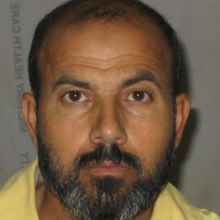Abu Muhannad al-Suwaydawi
Abu Muhannad al-Suwaydawi | |
|---|---|
 | |
| Birth name | Adnan Latif Hamid al-Suwaydawi al-Dulaymi |
| Born | 1965 Al-Khalidiya, Iraq |
| Died | 8 November 2014 (aged 48–49) Mosul, Nineveh Governorate, Iraq |
| Allegiance |
|
| Service/ | Iraqi Army (1986–2003) Military of ISIL (8 April 2013 – 8 November 2014) |
| Rank |  Colonel (until 2003) Colonel (until 2003)ISIL Wali (Governor) of Anbar (January 2014 – 8 November 2014) ISIL Military Chief (4 June 2014 – 8 November 2014)[1][2] |
| Battles/wars | 2003 Iraq War Iraqi insurgency Syrian Civil War |
Adnan Latif Hamid al-Suwaydawi al-Dulaymi (Arabic: عدنان لطيف حامد السويداوي الدليمي, ‘Adnān Laṭīf Ḥāmid as-Suwaydāwī al-Dulaymī) (1965 – 8 November 2014), also known by his noms de guerre Abu Muhannad al-Suwaydawi, Abu Abdul Salem,[3] and Haji Dawūd was a top commander in the Islamic State of Iraq and the Levant (ISIL) and the former head of its Military Council.[4]
Biography[edit]
Despite his senior position within the ISIL hierarchy, very little is known about al-Iraqi. He has been referred to as a "shadowy persona".[5] Al-Suwaydawi was a member of the Al-bu Swda clan of the Dulaim, the largest tribe in Iraq's Al Anbar Governorate. Al-Suwaydawi served under the Ba'athist regime of Saddam Hussein as a lieutenant colonel in the Iraqi Army.[6] He also operated in Iraq's Air Defense Intelligence.[7] According to Ahmed al-Dulaimi, the governor of Al Anbar Governorate, al-Suwaydawi graduated from the same military academy as future senior ISIL leaders Haji Bakr and Abu Abdulrahman al-Bilawi.[4]
An IS biography of Abu Muhannad al-Suwaydawi describes him as being "especially close to Abu Musab al-Zarqawi and Abu Abdulrahman al-Bilawi and says, "He and Abu Abdulrahman al-Bilawi were friends both in childhood and jihad". According to the biography, Abu Muhannad was present at both the First Battle of Fallujah and the Second Battle of Fallujah during the occupation of Iraq. He was also responsible for planning the 2013 Abu Ghraib prison break.[8] In 2007, al-Suwaydawi was detained by U.S. forces in Iraq at Camp Bucca. Following the deaths of Haji Bakr and al-Bilawi in 2014, al-Suwaydawi reportedly succeeded them as head of ISIL's military council.[4]
Death[edit]
In November 2014, there were media reports that al-Iraqi had been killed in an Iraqi airstrike that reportedly also injured Abu Bakr al-Baghdadi,[9][10] however this was not confirmed at the time. In May 2015, ISIL carried out a wide-scale assault on Ramadi, capturing the city centre. The assault was named after al-Suwaydawi, who was described as having been killed in a US-led air strike.[11][12] Jihadists frequently name their military offensives after fallen leaders.[13] The Daily Beast reported that al-Suwaydawi was succeeded by senior ISIL figure Abu Ali al-Anbari.[14]
In October 2019, an article for the BBC claimed al-Suwaydawi was killed fighting on the front line in Syria by the Syrian Democratic Forces rather than a US airstrike.[15]
References[edit]
- ^ "Military Skill and Terrorist Technique Fuel Success of ISIS". The New York Times. 27 August 2014. Retrieved 21 October 2014.
- ^ "Ex-U.S. detainees now ISIS leaders". CBS News. 11 November 2014. Retrieved 4 January 2022.
- ^ "Islamic State Senior Leadership: Who's Who" (PDF). 2014. Archived from the original (PDF) on 5 February 2015. Retrieved 8 October 2016.
- ^ a b c "Military skill and terrorist technique fuel success of ISIS". The New York Times. 27 August 2014. Retrieved 10 May 2016.
- ^ "A Late-Night Phone Call Between One Of Syria's Top Extremists And His Sworn Enemy". Buzzfeed. 4 April 2014. Retrieved 2 November 2014.
- ^ "Key Players: Who's Who in the Battle for Iraq?". NBC News. 14 June 2014. Retrieved 2 November 2014.
- ^ "Exclusive: Top ISIS leaders revealed". Al Arabiya. 13 February 2014. Retrieved 10 May 2016.
- ^ "ISIL extremists control centre of Iraqi city". The National. Abu Dhabi. 15 May 2015. Retrieved 10 May 2016.
- ^ Erin Cunningham (9 November 2014). "Fate of Islamic State chief unclear following U.S. airstrikes on group's leadership in Iraq". Washington Post.
- ^ Qassim Abdul-Zahra (9 November 2014). "Islamic State leader al-Baghdadi wounded by airstrike, Iraqi officials say". thestar.com.
- ^ Faraj, Salam (15 May 2015). "IS seizes government HQ in Iraq's Ramadi". Yahoo! News. Agence France-Presse. Archived from the original on 13 May 2016. Retrieved 10 May 2016.
- ^ "IS Claims Wide-Scale Assault on Ramadi, Suicide Bombings by British, Syrian, and Tunisian Fighters". Site Intelligence Group. 15 May 2015.(subscription required)
- ^ Joscelyn, Thomas (2 May 2016). "Series of deadly operations named after fallen Islamic State leader". The Long War Journal.
- ^ Hassan, Michael Weiss (15 April 2016). "Everything We Knew About This ISIS Mastermind Was Wrong". The Daily Beast. Retrieved 10 May 2016.
al-Qaduli handled the intelligence services, or amniyat, in the country, and then in both Syria and Iraq after the killing of Abu Muhannad al-Suwaydawi, a former Saddamist
- ^ "Abu Bakr al-Baghdadi: What his death means for IS in Syria". BBC News. 27 October 2019. Retrieved 28 October 2019.
